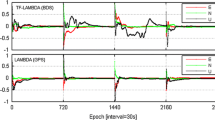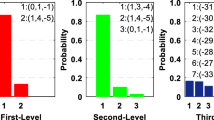Abstract
One of the most significant advantages of multiple frequencies is that it can improve the success rate of ambiguity resolution, such as the three-frequency carrier ambiguity resolution (TCAR) method. So far, the global BeiDou-3 navigation satellite system already provides four frequencies. Hence, we systematically study the models and methods of four-frequency carrier ambiguity resolution (FCAR) by using real BeiDou-3 data. First, the models of four-frequency linear combinations are given, and the optimal linear combinations are found out based on certain optimal criteria. Second, two typical methods, including geometry-free and geometry-based methods, are studied. In the end, the real BeiDou-3 data are used to evaluate the performance of the FCAR method, where two strategies, i.e., single-epoch and multi-epoch solutions, are both applied. The results indicate that the FCAR method can offer more high-quality virtual signals in quantity and quality than the TCAR method. By using the real BeiDou-3 data with different lengths ranging from 4.9 m to 61.6 km, three high-quality and independent signals can fix the ambiguities instantaneously with an approximately 100% success rate. Then the fourth independent signal can be fixed with high efficiency and success rate. Therefore, the FCAR method is promising in large-scale real-time precise positioning, where the successful ambiguity resolution may take tens of minutes to hours.




Similar content being viewed by others
Data availability
The observation data of this study are available from the corresponding author for academic purposes on reasonable request. They consist of 3 different baselines collected from Trimble Alloy receivers with BeiDou-3 data.
References
Chen D, Ye S, Xia J, Liu Y, Xia P (2016) A geometry-free and ionosphere-free multipath mitigation method for BDS three-frequency ambiguity resolution. J Geod 90(8):703–714
Cocard M, Bourgon S, Kamali O, Collins P (2008) A systematic investigation of optimal carrier-phase combinations for modernized triple-frequency GPS. J Geod 82(9):555–564
CSNO (2018) BeiDou navigation satellite system open service performance standard (version 2.0)
De Jonge P, Teunissen P, Jonkman N, Joosten P (2000) The distributional dependence of the range on triple frequency GPS ambiguity resolution. In: Proceedings of ION NTM 2000, Institute of Navigation, Anaheim, CA, January 26–28, 10–15
Feng Y (2008) GNSS three carrier ambiguity resolution using ionosphere-reduced virtual signals. J Geod 82(12):847–862
Feng Y, Li B (2008) A benefit of multiple carrier GNSS signals: regional scale network-based RTK with doubled inter-station distances. J Spat Sci 53(2):135–147
Feng Y, Rizos C (2005) Three carrier approaches for future global, regional and local GNSS positioning services: concepts and performance perspectives. In: Proceedings of ION GNSS 2005, Institute of Navigation, Long Beach, CA, September 13–16, 2277–2278
Forssell B, Martin-Neira M, Harris R (1997) Carrier phase ambiguity resolution in GNSS-2. In: Proceedings of ION GPS 1997, Institute of Navigation, Kansas City, MO, September 16–19, 1727–1736
Hatch R, Jung J, Enge P, Pervan B (2000) Civilian GPS: the benefits of three frequencies. GPS Solut 3(4):1–9
Ji S, Chen W, Zhao C, Ding X, Chen Y (2007) Single epoch ambiguity resolution for Galileo with the CAR and LAMBDA methods. GPS Solut 11(4):259–268
Li B (2018) Review of triple-frequency GNSS: ambiguity resolution, benefits and challenges. J Glob Position Syst 16:1
Li B, Feng Y, Shen Y (2010) Three carrier ambiguity resolution: distance-independent performance demonstrated using semi-generated triple frequency GPS signals. GPS Solut 14(2):177–184
Li B, Shen Y, Feng Y, Gao W, Yang L (2014a) GNSS ambiguity resolution with controllable failure rate for long baseline network RTK. J Geod 88(2):99–112
Li T, Wang J, Laurichesse D (2014b) Modeling and quality control for reliable precise point positioning integer ambiguity resolution with GNSS modernization. GPS Solut 18(3):429–442
Li B, Li Z, Zhang Z, Tan Y (2017) ERTK: extra-wide-lane RTK of triple-frequency GNSS signals. J Geod 91(9):1031–1047
Tang W, Deng C, Shi C, Liu J (2014) Triple-frequency carrier ambiguity resolution for Beidou navigation satellite system. GPS Solut 18(3):335–344
Teunissen P, Joosten P, Tiberius C (2002) A comparison of TCAR, CIR and LAMBDA GNSS ambiguity resolution. In: Proceedings of ION GPS 2002, Institute of Navigation, Portland, OR, September 24–27, 2799–2808
Verhagen S, Tiberius C, Li B, Teunissen P (2012) Challenges in ambiguity resolution: biases, weak models, and dimensional curse. In: Proceedings of NAVITEC 2012 6th, ESA Workshop, Noordwijk, Netherlands, 1–8
Vollath U, Birnbach S, Landau L, Fraile-Ordonez J, Marti-Neira M (1998) Analysis of three-carrier ambiguity resolution technique for precise relative positioning in GNSS-2. Navigation 46(1):13–23
Wang K, Rothacher M (2013) Ambiguity resolution for triple-frequency geometry-free and ionosphere-free combination tested with real data. J Geod 87(6):539–553
Werner W, Winkel J (2003) TCAR and MCAR options with Galileo and GPS. In: Proceedings of ION GPS/GNSS 2003, Institute of Navigation, Portland, OR, September 9–12, 790–800
Yang Y, Gao W, Guo S, Mao Y, Yang Y (2019) Introduction to BeiDou-3 navigation satellite system. Navigation 66(1):7–18
Yang Y, Mao Y, Sun B (2020) Basic performance and future developments of BeiDou global navigation satellite system. Satell Navig 1:1
Zhang X, He X (2016) Performance analysis of triple-frequency ambiguity resolution with BeiDou observations. GPS Solut 20(2):269–281
Zhang Z, Li B (2020) Unmodeled error mitigation for single-frequency multi-GNSS precise positioning based on multi-epoch partial parameterization. Meas Sci Technol 31(2):025008
Zhao Q, Dai Z, Hu Z, Sun B, Shi C, Liu J (2015) Three-carrier ambiguity resolution using the modified TCAR method. GPS Solut 19(4):589–599
Acknowledgements
This study is sponsored by State Key Laboratory of Rail Transit Engineering Informatization (FSDI) Grant (SKLK20-07), China Postdoctoral Science Foundation (2020M671324), Fundamental Research Funds for the Central Universities (2019B03714), Jiangsu Planned Projects for Postdoctoral Research Funds (2020Z412), the State Key Laboratory of Geodesy and Earth’s Dynamics Grant (SKLGED2020-3-8-E) and the National Natural Science Foundation of China (41830110, 41874030). The authors thank the anonymous reviewers for their constructive comments.
Author information
Authors and Affiliations
Corresponding author
Additional information
Publisher's Note
Springer Nature remains neutral with regard to jurisdictional claims in published maps and institutional affiliations.
Rights and permissions
About this article
Cite this article
Zhang, Z., Li, B., He, X. et al. Models, methods and assessment of four-frequency carrier ambiguity resolution for BeiDou-3 observations. GPS Solut 24, 96 (2020). https://doi.org/10.1007/s10291-020-01011-z
Received:
Accepted:
Published:
DOI: https://doi.org/10.1007/s10291-020-01011-z




